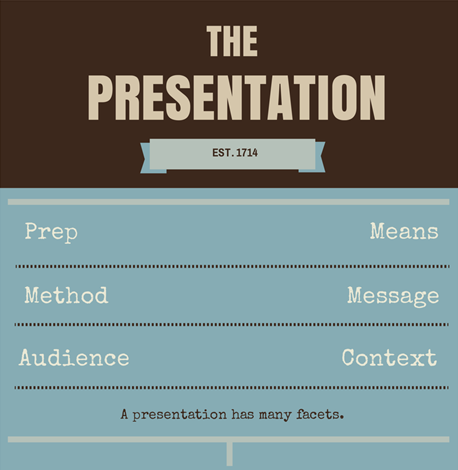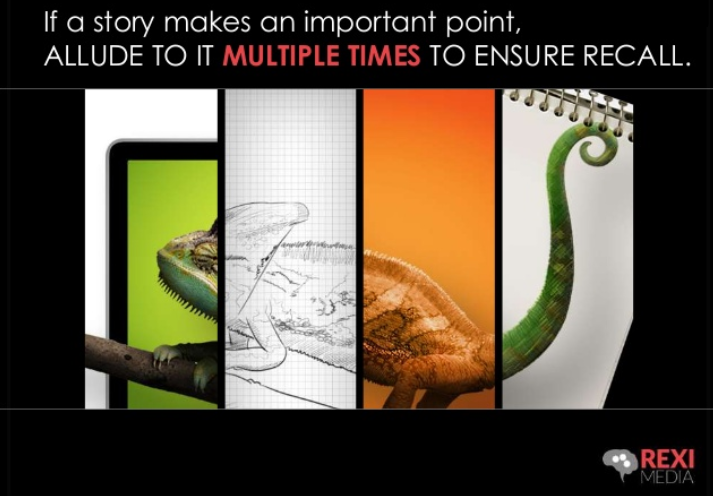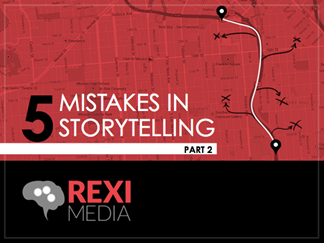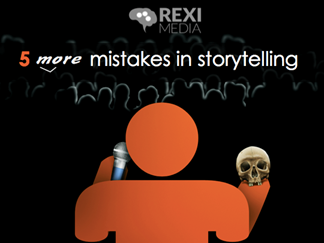
Carmen Simon is founder of Memzy, a company that "applies science-based guidelines to help you create memorable content in a deliberate way and stay on people’s minds long-term."
I've done some work with Carmen and have always been a fan of her teachings, presentations and webinars. Recently, I was scanning my SlideShare feed when one of her presentations caught my eye. That gave me the occasion to check in with Carmen and ask whether she'd share some of her secrets to creating memorable stories and presentations. The result is this interview.
Tell us about yourself, Carmen?
I am a scientist, I have two doctorate degrees, and two addictions:
one to studying the human brain and one to tennis. I once played tennis in
stilettos on a stage before a keynote. My latest applied research has been in
the area of using neuroscience to transform presentations.
What are three essential elements to a compelling presentation?
Before listing essential elements, let’s look at the word “presentation,”
as it is multifaceted. Let’s consider a presentation the
preparation, means, and method of communicating a message to various audiences in various contexts.

Each of these emphasized words from the definition can be linked to what
can make a presentation "compelling." Take the word
preparation, for example. Presentations are often good because
presenters come well prepared versus shuffling things at the last minute (the
“Oh-I-did-not-know-this-was-going-to-be-on-this-slide…” type of statements).
Then there are the
means for
presenting: is it slides, or a mere conversation? Will you use any other tools
during presenting? A lot more people present with an iPad these days, which can
be sexy if you know how to do it well. I am always impressed with people who
can deliver a good presentation over the phone: no visuals, just voice. It
takes skill.
Then there is the
method: is
it following a specific structure or is it more informal or ad-hoc? I am
delighted at those speakers who know they must follow a method (let’s say a
selling method), yet they are willing to deviate and go where the audience
takes them. That’s compelling.
As for the
message, you can
have informative presentations, instructional, or persuasive presentations. Sometimes
a presentation is not compelling just because of the message. For example, it’s
difficult to sustain attention for a long time with an informative
presentation. This is why “status update presentations” longer than three
minutes are snoozers.
As for the
audience: is it a
small one or large one? Internal or external? Sometimes what’s compelling
in-house falls flat in front of customers. And the
context? Take the difference between face-to-face and virtual
presentations.
Many virtual events are not compelling because presenters have not
learned new habits – they deliver virtual sessions with the attitude of “I am
doing fine face-to-face, how difficult can it be virtually, especially when no
one sees me and I can escape the dreadful eye contact?”
So back to your question about three elements essential for a
compelling presentation, and using neuroscience findings, I am convinced they
are:
- Attention
- Memory
- Decision-making
These three components tie all the various parts of a presentation,
including preparation, means, method, message, audience, and context.
<
What's the most common mistake you see in storytelling?
I see a lot of presenters who think they are sharing stories, when in
reality, they are sharing facts. A good story must have a setting, at least a
character, a plot (where something happens for a purpose), some conflict to be
solved, and resolution.
Most of these components are often missing in business presentations. Take
the
plot component for example. Typically,
either nothing happens or nothing
unexpected
happens. You set a goal, work toward the goal, and meet the goal. Too many
business stories are predictable stories.
How do you find the captivating (OK, stunning!) visuals in your presentations?
Thank you so much for the compliment! It’s often hard to
find a great visual. From my 20 years of
presentation research, I can say with certainty that
finding a great visual
that matches your content is serendipity.

It can happen and it feels great: let’s say you’re browsing through a
stock photo database and see something you like. I was once giving a speech on the
“Psychology of Absence” and found a picture of three pears cut in half: BINGO!
But you cannot count on serendipity.
In addition, other people may find what you found, and that’s how
visuals become cliché. Have you seen those pictures with a fish jumping from
one small bowl to a bigger bowl? Or two hands holding a pretty plant sticking
out from some dirt? All these pictures were great the first few times we saw
them. They are now overly used and we tune them out. If I never see the cat that
looks in the mirror and sees a lion ever again, it will be OK!
Most great visuals are
created
(not merely found) and either you hire talented designers or you create your
own visuals. Sometimes visuals captured by presenters are more powerful because
they are authentic and not super waxed, like stock photos.
If everyone is being encouraged to tell stories, how do you make YOUR story
stand out?
Even though everyone is encouraged to tell stories, most people do not
know how and when to tell a story well. I remember listening to a keynote
speaker a few months ago. He started telling what could have been a good story,
but three minutes before his time was up.
Bad move for everyone. He had to rush the story, missing details and
feeling stressed; the audience missed most of the story because, by that time,
they were ready to listen to the next speaker.
Even when timed well, most stories in business settings fail at these
two things:
- Visuals
- Context
Many presenters have not learned how to build vibrant visuals in an
audience’s mind, and place them in a context that is easy to picture. Check out
this paragraph from writer Larry Watson:
"My father kneels on the kitchen floor, begging my mother to help him.
It’s a summer night and the room is brightly lit. Insects cluster around the
light fixtures, and the pleading quality in my father’s voice reminds me of
those insects – high-pitched, insistent, frantic. It is a sound I have never
heard coming from him."
Could you see the kitchen, the father kneeling, the insects? This is
the power of strong visuals placed in context. And this combination
distinguishes a story from a bland one.
Of course, you might say: how would this story fit within a business
context? Imagine you heard this from a CEO:
"When I was 10, I would pick up my cousin Robbie and head up to the
river behind grandma’s house. We would find a stick each, then go over a wooden
bridge and drop the sticks in, at the upstream side of the bridge, then hurry
over to the other side. The first stick to appear would decide the winner. We would repeat
until sundown. Thinking back, this was such an impractical game, yet we felt so
close, so connected. I miss that kind of human connection today, when cell phones,
emails, and texts divide us. How could we bring this human connection back?"
Once you learn how to build vibrant images in a context and tie them
to a practical business purpose, you have distinguished your story from many
other stories.
Please share one "easy win" with regard to SlideShare?

A successful SlideShare is one where people click, then share, and then
their friends click, and they share, and their audience’s
audiences click and then share. Beyond clicks, shares, and “likes,” a major
bonus is when you also get people to act (e.g. purchase a service advertised in
the process).
Unfortunately, the daily explosion of news streams, emails, texts,
tweets, or phone calls exposes our cognitive processes to major information
overload. This is one of the reasons why it’s becoming increasingly difficult
to get people to click and share. Virality is difficult to predict. There are
some steps that will increase the chances for a hit: create good/timely
content, frame it in an irresistible way, and publish as many SlideShares as
you can.
Timely content is key. These days I see quite a few SlideShares
related to soccer and the currency of the topic makes it irresistible. Imagine
if I were to publish a SlideShare on "How to Pick Out the Ideal Summer
Swimsuit" but the summer was almost over.

Modern people live in the now. It is not difficult to transform
outdated titles. Instead of "Are Google Glasses the Way of the Future," imagine
saying, "4 Ways Google Glasses Are Changing the Present." And the one "easy
win," when you do have timely content, is to make sure that the font size on
the first screen is huge (at least 96pt). If it’s easy to read from the
thumbnail that SlideShare generates automatically, it is more inviting to
click.
Framing the content is critical too because, scientifically speaking, you
have to catch the audience at a perfect intersection of emotion and
entertainment (where they feel frustrated enough about a topic but entertained
enough to want to click and share).
For example, in the Storytelling SlideShare, I plan to do
an experiment. The file is based on two parts. For the second part, which is
coming out in a few weeks, the first screen will have a combination of emotion
and entertainment. The first example [see first example, above, and to the left] would be
logical to use because it is similar to part 1 - it is professional, but bland. The
second one (a temporary draft) has some wit in it [you can see above]. I will let you know which
does better.
If you're designing for SlideShare vs. designing for a "live
presentation," how do you approach things differently?
A SlideShare is a standalone document, so it must “carry” complete
information because the presenter is not there to defend the content. From a
brain science perspective, this presents a challenge because people retain
information better when the visual channel and the audio channel work
collaboratively.
On SlideShare, images + text are the default means, a combination
which has the potential to overwhelm the visual channel. A solution to this is
to stay light on text when you have a powerful image, or light on images when
you display more text. You can still make a strong point with text alone. Think
50pt size.
How can marketers make their presentations more memorable?
Let’s ask the opposite question: why do people forget presentations?
You might enjoy a Slideshare I did on this, check it out:
5 Reasons We Forget Presentations from Rexi Media
What advances in technology do you foresee, related to presentations?
It excites me to picture the future because currently so much in
presentations depends on technology, and technology does not advance linearly,
it advances exponentially. For example, right now, it is annoying that when you
rent conference rooms, you have to pay for a projector screen and a projector. In
the future, everything will have a chip in it and will be connected to the
Internet; walls or furniture would be able to display our files and log us in. A
presentation may easily look like a scene from the
Minority Report.

Photo source: User lawrencegs on
flickr.
Also, imagine the transition from the Google Glasses to the Internet
being available through contact lenses. This means that as you speak to an
audience, you may have seamless access to your notes, which will decrease the
pressure of “what if I lose my train or thought or forget something important?”
And since pattern-recognition will be part of these lenses, you will be able to
detect details about your audience and establish a stronger connection (e.g.
addressing people in your audience by name or linking your content to their
interests faster).
In the future, if you’re presenting in Austin, you may be able to
project your image (hologram) on a stage in Adelaide. The universal translator
will soon be here too, which will mean that you can speak to any audience,
without the need of an interpreter.
Of course, any advancement will present some challenges as well. For
example, if you rely on seeing your notes as you speak, you will need
additional skills to avoid sounding like a robot.
All these futuristic plans will be possible only if we have smart
software people who can sit down and write code line by line. So if you know a
software engineer, buy them some cookies and give them a hug.